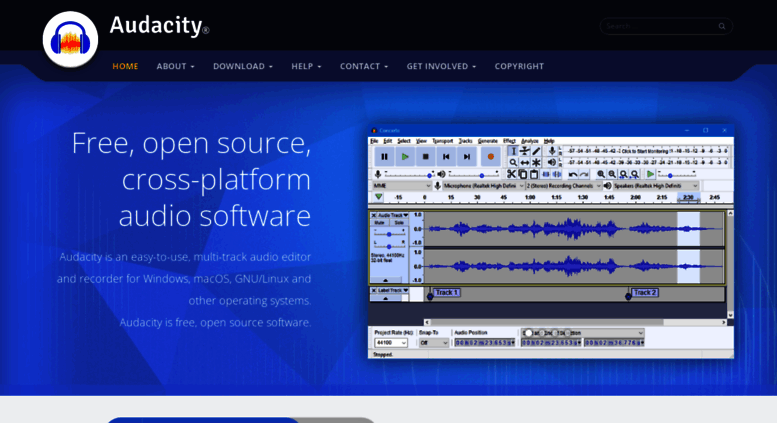
The optional FFmpeg library allows Audacity to import and export a much larger range of audio formats including M4A (AAC), AC3, AMR (narrow band) and WMA and also to import audio from most video files. Because of software patents, Audacity cannot include the FFmpeg software or distribute it from its own websites. Instead, use the following instructions to download and install the free. Audacity is a free and open-source digital audio editor and recording application software, available for Windows, macOS, Linux, and other Unix-like operating systems. Audacity was started in the fall of 1999 by Dominic Mazzoni and Roger Dannenberg at Carnegie Mellon University and was released on May 28, 2000 as version 0.8. As of October 24, 2020, it is the most popular download from. There are many tools in this category, but few so comprehensive and efficient as Audacity. It is a free, open source software with GNU licensing to record and edit audio, working directly with the graphics of the sound waves.
Audacity is an Open Source audio application designed to be a full-featured, yet easy to use multi-track recording and editing suite. Audacity can record live audio through a microphone, mixer, digitize recordings from other media, and capture streaming audio. Managing Audacity Projects - Audacity's internal workspace; Audacity Setup and Configuration. Preferences - changing your settings and reset to default; Toolbars Overview - including how to arrange Toolbars; Audio Tracks, Waveform view and Spectrogram.
Download Audacity 2020
vst-bridge-1.1.exe (Windows Installer)
vst-bridge-1.1-win.zip (Windows ZIP file)
vst-bridge-1.1.dmg for macOS
vst-bridge-1.1.tar.gz (Source code)
Audacityteam.org/download/
Version, 1.1
This plug-in allows Audacity 1.2.4 and higher to support VST plug-ins. Just put it in Audacity's 'Plug-ins' folder. For more information on VST plug-ins, see Audacity's Plug-ins page.
To use with Audacity: just copy vst-bridge.so or vst-bridge.dll to the Plug-ins folder inside of your Audacity folder.
The Mac version is a universal binary.
This library makes it possible for programs which support the LADSPA API to load VST plug-ins. Simply place the library into any folder where LADSPA plug-ins are loaded, and it will automatically load all VST plug-ins and make them appear as LADSPA plug-ins.
VST plugins are searched for in this order:
The current directory
The path specified by the VST_PATH environment variable, if any
On Windows, additionally:
The first of the following to be found: HKEY_CURRENT_USERSoftwareVSTVSTPluginsPath HKEY_LOCAL_MACHINESoftwareVSTVSTPluginsPath C:Program FilesSteinbergVSTPlugins
On OS X, additionally:
The users ~/Library/Audio/Plug-Ins/VST directory
The system /Library/Audio/Plug-Ins/VST directory
The Windows version now looks for plugins in standard locations as well as the current directory and the VST_PATH environment variable. First, it tries to locate the 'standard' VST registry key and, if not found, looks in 'Program FilesVSTVSTPlugins'. Combat warfare 5.
Because of licensing issues, VST support must be kept separate from Audacity. This 'VST Enabler' is mostly open-source, but the source code to Steinberg's VST SDK is required, and this must be downloaded from Steinberg separately.
Update 2.2.1: VST Plug-ins Audacity can load VST effects (but not VST instruments) on all operating systems. The VST Enabler is no longer required. Install the VST effects to the Audacity Plug-Ins folder on Windows, to ~/Library/Application Support/audacity/Plug-Ins on OS X/macOS or to system locations. Then use the Plug-ins Manager to enable the new plug-ins as in the plug-in installation instructions above.
Related VST (dll) To Mac (Adapters / Hosts):
What Is Official Website For Audacity
Excel spreadsheet application. WACVST (Windows-Mac VST)VSTAU ManagerAudacity VST Enabler

